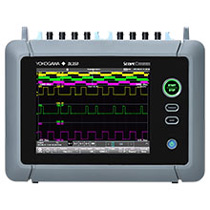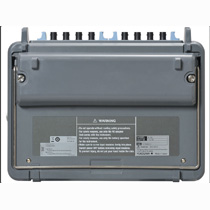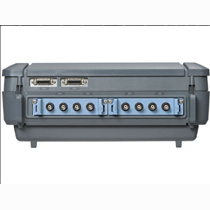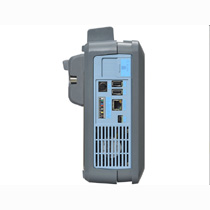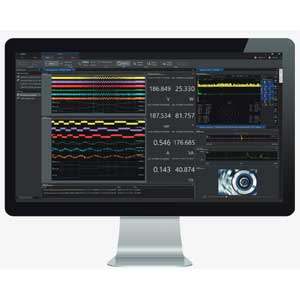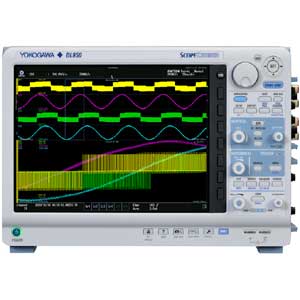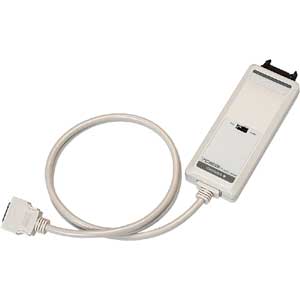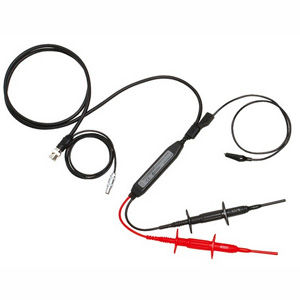Maximum 32-Channels Analog Input in a Battery-Operated Compact Chassis
Choose from 18 types of input module and install up to 2 in a ScopeCorder at a time to configure a ScopeCorder up to 32 channels.
- A4-sized compact chassis
- Simultaneous isolated inputs maximum
8-ch (1 MS/s) or 4-ch (100 MS/s)
Scanning inputs maximum 32-ch
(10 kS/s) or 16 channels (20 kS/s) - AC/DC/Battery operated

Flexible recording in a single portable tool with superior noise immunity and vibration resistance
Flexible input
Choose from 18 types of input modules that are compatible with other ScopeCorders

Vibration resistant
Instruments used for in-vehicle driving tests or field maintenance must be able to make reliable measurements. The DL350 has an aluminum inner frame and an external rubber bumper and conforms to the Japanese JIS D1601 standard for resisting in-vehicle shock and vibration.

Operates in freezing temperatures
Even when used with the rechargeable battery, the DL350 will operate in temperatures from 0 to 45 degrees. The DL350 brings high-quality laboratory measurements into the harsh environments of the field.

High-speed and long-term recording using large memory and direct recording onto an SD card
- Up to 100 Mega-points per module memory
- Up to 50 days continuous recording onto SD card

Ease of use in the field
- Intuitive operation using 8.4 TFT touch screen
- A choice of two operating modes, oscilloscope or data recorder
- DL350 Assistant Software helps configure settings and back up data on the spot

More than a test tool
The DL350 ScopeCorder combines in one compact instrument all the measurement and recording capabilities you need when you are away from your office or lab. The DL350 provides the flexibility you need when you need it: whether you are recording high-speed transients or long-term signals, using ‘quick and simple’ setup or advanced features.
Complete self-contained signal conditioning
Whether it is straightforward high precision voltage measurements or a blend of signals coming from such things as current probes, temperature sensors, strain gauges, accelerometers and serial buses, the DL350 can handle them all without extra boxes or cables.
This extraordinary input capability is achieved by providing 2 slots, which can be populated with any of 18 different types of user-swappable input modules. This means, for example, that 4 isolated 16-bit voltage inputs can be measured at 1 MS/s, alongside 16 temperatures. Swap a module and measure at 100 MS/s with 12-bit and 1 kV of isolation. Meanwhile there are 16 built-in logic inputs; swap in a digital input module to add even more. Make AC measurements like a DMM with an RMS module in real-time or use a math channel after the recording is finished.

Use it like a data acquisition system or a long memory oscilloscope
Up to 5 Gpoints of data per module can be recorded directly to an SD card. This means that the DL350 can be used for continuous recording for up to 50 days. For high speed signals, up to 100 M points per module of internal memory is available to capture fast transients. This is up to 10,000 times more than other portable oscilloscopes or test tools and thus signals can be captured with higher sample rates or for much longer periods.
Accurate measurement of fast-switching waveforms
Unique amongst portable measuring instruments, there is a high-resolution high-speed sampling module available for the DL350. This provides individually isolated 12-bit, 100 MS/s inputs, which can precisely measure and record transient waveforms superimposed on slower signals. For example, transients occurring on inverter outputs, or the edges of control signals, which are beyond the reach of traditional handheld test tools.

Comprehensive testing made easy
Full recording flexibility
For users who are more familiar with chart recorders than with long memory oscilloscopes, the DL350 offers a choice of operating modes. Recorder mode is suitable for long-term continuous recording for a specific duration and where the sampling interval is specified. A setup wizard can be used in this mode to quickly guide the operator through the entire setup process.

Scope mode enables the DL350 to be used just like an oscilloscope with all the associated benefits, such as comprehensive triggering and flexible memory use. Using the history memory enables up to 1,000 separate triggered acquisitions to be captured to the internal memory and viewed afterwards. Thus the causes and effects of abnormalities can be carefully analyzed as easily as paging through a photo album.

Intuitive operation
An 8.4-inch resistive touch screen has been adopted in order to deliver superior noise-free performance. In environments with the highest levels of electrical noise such as motors and inverters, measurement precision is maintained while enabling the unit to be operated by using (gloved) fingers or stylus.

Even when the backlight is switched off and the touch screen is inactive the user still has access to the START/STOP, manual trigger and data saving keys. For users unfamiliar with state-of-the-art measuring instruments, there is also help at hand via the built-in digital manual.
A wealth of triggers for fault finding
The user has a choice of a simple level trigger or can use enhanced triggers such as pulse width, waveform period and triggers across multiple channels. For example, the wave window trigger is ideal for AC power line monitoring which enables voltage sags, surges, spikes, phase shifts or drop outs to be easily captured (available for 40 to 1,000 Hz waveforms).
Leave a DL350 unattended and automatically save the waveform to a file or send a notification email if and when it triggers.

External sampling clock and triggers
The DL350 is first and foremost a field tool, however it still provides the functionality you expect in a bench instrument. The sampling clock, trigger and start/stop controls are all available as external signals. For example, a rotary angle encoder or degree wheel can be used as the sample clock to analyze engine rotation and performance.

Isolation
Input modules used in the DL350 ScopeCorder are compatible with the DL850E and DL850EV ScopeCorders, and the SL1000. The DL350 inherits the technological developments of more than 30 years of commitment to the measurement needs of electromechanical systems.
isoPROTM – pioneering measurement technology
Input modules are powered by YOKOGAWA’s isoPRO™ technology, which offers industry-leading isolation performance at the highest speeds. isoPRO™ core technology, designed with energy-saving applications in mind, delivers the performance needed to develop high-efficiency inverters that operate at high voltages, large currents and high frequency.
The use of optical fibers enables the achievement of high speed data transmission and high voltage isolation.

Higher voltage registration and better CMRR
720268 High Voltage Input Module The new high-Voltage, high-resolution, 1 MS/s 16 bit Isolation Module (model 720268), which is also capable of direct RMS measurements, has an improved sample rate (1 MS/s) and an improved maximum input voltage (1000 Vrms).
Normally, to realize high insulation performance in a small package, it is necessary to raise the input impedance and lower the voltage of the internal circuit. However the increase in input impedance causes a reduction in the common-mode rejection ratio (CMRR) and measurement accuracy.
Thanks to the new digital isolator in this module, high voltage input signals can be acquired without an increase in size. High insulation performance is maintained without compromising the CMRR.

Consistent measurement results in R&D and maintenance
Traditionally different measuring instruments of various sizes and capabilities are used in the R&D lab and in the field. Since the accuracy, noise immunity and other characteristics are not the same, engineers struggle to correlate measurements.
The plug-in modules of the DL350 are common* to those of the DL850E and DL850EV, the higher-end ScopeCorder models. By using common* modules for product design, validation and on-site maintenance, the high quality of the measurements is consistent.
*With some exceptions


